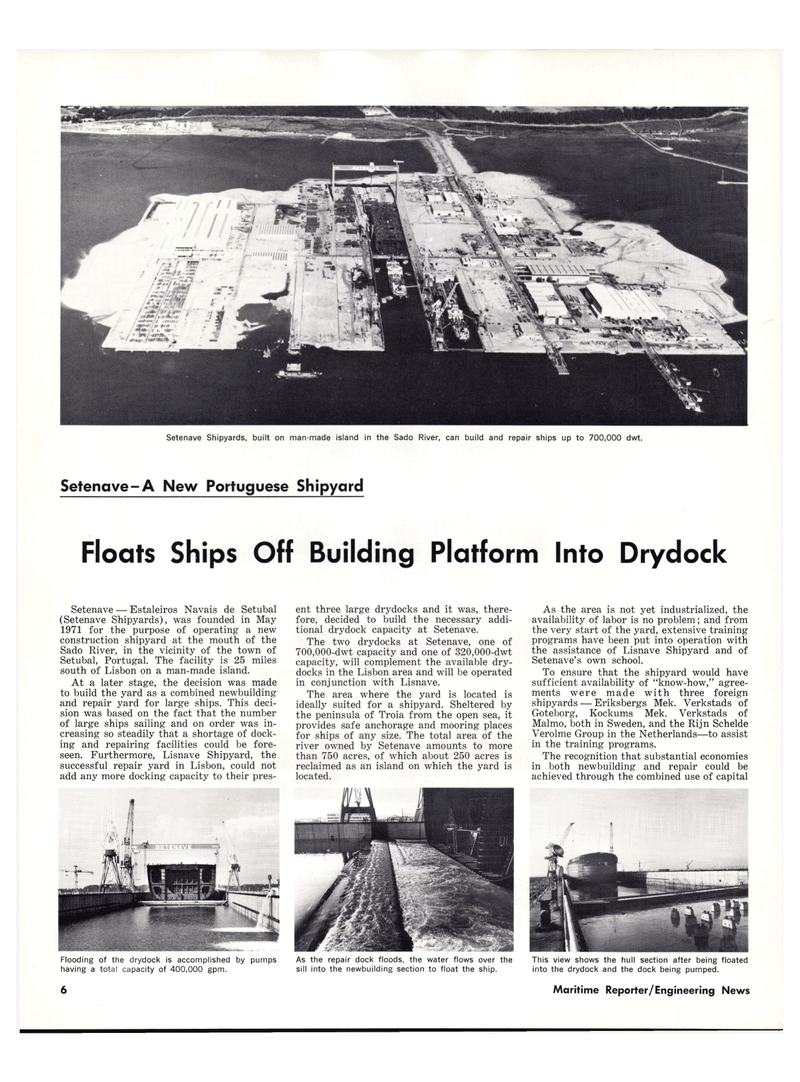
Page 4: of Maritime Reporter Magazine (April 1976)
Read this page in Pdf, Flash or Html5 edition of April 1976 Maritime Reporter Magazine
awwwwv
Setenave Shipyards, built on man-made island in the Sado River, can build and repair ships up to 700,000 dwt.
Setenave-A New Portuguese Shipyard
Floats Ships Off Building Platform Into Drydock
Setenave — Estaleiros Navais de Setubal (Setenave Shipyards), was founded in May 1971 for the purpose of operating a new construction shipyard at the mouth of the
Sado River, in the vicinity of the town of
Setubal, Portugal. The facility is 25 miles south of Lisbon on a man-made island.
At a later stage, the decision was made to build the yard as a combined newbuilding and repair yard for large ships. This deci- sion was based on the fact that the number of large ships sailing and on order was in- creasing so steadily that a shortage of dock- ing and repairing facilities could be fore- seen. Furthermore, Lisnave Shipyard, the successful repair yard in Lisbon, could not add any more docking capacity to their pres-
Flooding of the drydock is accomplished by pumps having a total capacity of 400,000 gpm.
As the repair dock floods, the water flows over the This view shows the hull section after being floated sill into the newbuilding section to float the ship. into the drydock and the dock being pumped. ent three large drydocks and it was, there- fore, decided to build the necessary addi- tional drydock capacity at Setenave.
The two drydocks at Setenave, one of 700,000-dwt capacity and one of 320,000-dwt capacity, will complement the available dry- docks in the Lisbon area and will be operated in conjunction with Lisnave.
The area where the yard is located is ideally suited for a shipyard. Sheltered by the peninsula of Troia from the open sea, it provides safe anchorage and mooring places for ships of any size. The total area of the river owned by Setenave amounts to more than 750 acres, of which about 250 acres is reclaimed as an island on which the yard is located.
As the area is not yet industrialized, the availability of labor is no problem; and from the very start of the yard, extensive training programs have been put into operation with the assistance of Lisnave Shipyard and of
Setenave's own school.
To ensure that the shipyard would have sufficient availability of "know-how," agree- ments were made with three foreign shipyards — Eriksbergs Mek. Verkstads of
Goteborg, Kockums Mek. Verkstads of
Malmo, both in Sweden, and the Rijn Schelde
Verolme Group in the Netherlands—to assist in the training programs.
The recognition that substantial economies in both newbuilding and repair could be achieved through the combined use of capital 6 Maritime Reporter/Engineering News

 3
3

 5
5
